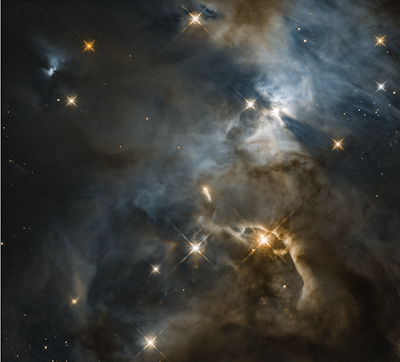Το
τηλεσκόπιο Hubble
εντόπισε μια «διαστημική νυχτερίδα να κουνάει τα φτερά της». Astronomers
using Hubble previously captured a remarkable image of a young star's unseen,
planet-forming disk casting a huge shadow across a more distant cloud in a
star-forming region. The star is called HBC 672, and the shadow feature was
nicknamed the "Bat Shadow" because it resembles a pair of wings. The
nickname turned out to be unexpectedly appropriate, because now those
"wings" appear to be flapping! Credits:
NASA, ESA, and STScI
Ένα
μοναδικό άστρο αποτύπωσε το θρυλικό διαστημικό τηλεσκόπιο Hubble. Πρόκειται για
ένα άστρο που περιτριγυρίζεται από ένα δίσκο σκόνης και αερίων δημιουργώντας
έτσι την εικόνα ότι το άστρο έχει… φτερά νυχτερίδας.
Το
νεαρό αυτό αστέρι, ηλικίας μόλις… δύο εκατομμυρίων ετών ονομάζεται HBC 672 και
απέχει από τη Γη 1.400 έτη φωτός.
In 2017, NASA’s
Hubble Space Telescope captured an image of a huge wing-shaped shadow cast by a
fledgling star’s unseen, planet-forming disk. The young star, called HBC 672,
is casting the shadow across a more distant cloud in a star-forming region—like
a fly wandering into the beam of a flashlight shining on a wall. Now, after
observing the shadow again, astronomers report that they see the giant shadow
flapping its "wings"! Video credit: NASA's Goddard Space Flight
Center
Το
Hubble «φωτογράφισε» το HBC 672 το 2018, αλλά μόλις πριν από λίγες μέρες
ολοκληρώθηκε η έρευνα για το εύρημά του.
This illustration
shows a fledgling star surrounded by a warped, saddle-shaped disk with two
peaks and two dips. A planet embedded in the disk, inclined to the disk's
plane, may be causing the warping. As the disk rotates around the young star,
it is thought to block the light from that star and cast a varying, flapping
shadow on a distant cloud. Credits: NASA, ESA, and A. James and G. Bacon
(STScI)
Οι
επιστήμονες πιστεύουν πως η κίνηση, που μοιάζει με τίναγμα φτερών, προκαλείται
από έναν πλανήτη, ο οποίος «τραβάει» τον δίσκο των αερίων και σκόνης και τον
χτυπάει.
This animation
depicts how the “flapping” motion of the shadow of the star HBC 672 has been
observed by the NASA/ESA Hubble Space Telescope. The star is believed to be
surrounded by a warped, saddle-shaped disc with two peaks and two dips. A
planet embedded in the disc, inclined to the disc’s plane, may be causing this
warping. As the disc rotates around the young star, it blocks the light from
that star and casts a varying, “flapping” shadow on a distant cloud. Credit: ESA/Hubble,
L. Calçada. Music: Konstantino Polizois
«Η
σκιά κινείται. Χτυπάει, σαν τα φτερά ενός πουλιού», δήλωσε ο αστρονόμος Κλάους
Ποντοπίνταν του Ινστιτούτου Επιστημών Διαστημικών Τηλεσκοπίων.
Πηγές:
https://arxiv.org/abs/2006.05965
- https://www.nasa.gov/feature/goddard/2020/hubble-sees-cosmic-flapping-bat-shadow/
- https://www.in.gr/2020/06/28/tech/monadiko-astro-moiazei-na-exei-ftera-nyxteridas/


